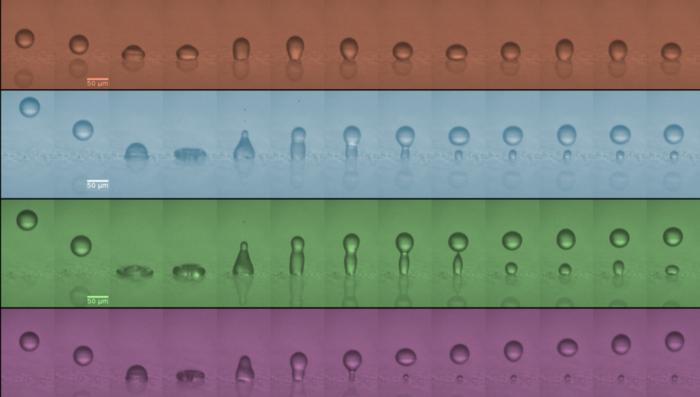Science
Physicists Uncover Secrets of Droplet Behavior on Hydrophobic Surfaces

Researchers from the University of Bath and the University of Cambridge have revealed new insights into the behavior of microscopic water droplets on water-repelling surfaces. This research has significant implications for various applications, including agricultural practices and the spread of airborne diseases.
In a study led by Jamie McLauchlan, a PhD student at the University of Bath, the team conducted experiments and simulations to explore how droplets interact with hydrophobic surfaces. Traditionally, it was assumed that the speed of a droplet determined whether it would stick or bounce off a surface. However, their findings indicate a more complex relationship. “If the droplet moves too slowly, it sticks. If it moves too fast, it sticks again,” explains McLauchlan. “Bouncing is possible only at intermediate speeds, where the droplet has enough momentum to detach from the surface but not so much that it collapses back onto it.”
This research also identified a size effect: droplets that are too small cannot bounce, regardless of their speed. The team determined that this limit is influenced by the viscosity of the droplets, preventing the smallest ones from detaching once they land. As McLauchlan notes, “We aimed to extend our understanding to micrometre-sized droplets and faster speeds, especially given the concerns raised during the COVID-19 pandemic about how small airborne respiratory droplets interact with surfaces.”
To carry out their study, the researchers utilized a high-speed camera capable of recording at a rate 100,000 times slower than real-time. They produced droplets using piezoelectric generators with extremely fine nozzles, a process that proved to be delicate due to the risk of clogging and damage to the equipment. The team created droplets ranging from 30 to 50 micrometers in diameter, impacting hydrophobic surfaces at velocities between 1 and 10 meters per second.
The researchers compared their experimental results to calculations based on a mathematical model that treats a droplet as a tiny spring. This model considers factors such as the stickiness of the surface, the viscosity of the droplet, and the droplet’s surface tension. Previous studies had primarily focused on larger droplets, but McLauchlan’s team examined a broader range of hydrophobic surfaces, discovering that bouncing behavior is influenced by a delicate interplay of kinetic energy, viscous dissipation, and interfacial energies.
McLauchlan expressed enthusiasm about the implications of their findings, stating that this framework could facilitate the engineering of microdroplets for targeted applications. For example, in agriculture, understanding the interaction between spray velocities and plant surfaces could optimize droplet deposition, improving the efficiency of crop spraying.
The study also holds potential for addressing concerns related to airborne diseases. Droplets that adhere to surfaces are removed from the air, ceasing to transmit pathogens. In contrast, droplets that bounce remain airborne, which can influence the spread of diseases in indoor environments. McLauchlan suggested that by quantifying these processes, researchers can develop better models of airborne pathogen concentrations, especially in healthcare settings. “Coatings could be designed to either inhibit or promote bouncing, depending on the mode of transmission we aim to target,” he stated.
Looking ahead, the research team plans to expand their investigations to droplets with more complex properties, incorporating surfactants and polymers that mimic biological fluids. “These studies will present significant experimental challenges, but we hope they will broaden the relevance of our findings across various fields,” McLauchlan concluded.
The findings are detailed in the journal PNAS.
-

 Health3 months ago
Health3 months agoNeurologist Warns Excessive Use of Supplements Can Harm Brain
-

 Health3 months ago
Health3 months agoFiona Phillips’ Husband Shares Heartfelt Update on Her Alzheimer’s Journey
-

 Science2 months ago
Science2 months agoBrian Cox Addresses Claims of Alien Probe in 3I/ATLAS Discovery
-

 Science2 months ago
Science2 months agoNASA Investigates Unusual Comet 3I/ATLAS; New Findings Emerge
-

 Science1 month ago
Science1 month agoScientists Examine 3I/ATLAS: Alien Artifact or Cosmic Oddity?
-

 Entertainment5 months ago
Entertainment5 months agoKerry Katona Discusses Future Baby Plans and Brian McFadden’s Wedding
-

 Science1 month ago
Science1 month agoNASA Investigates Speedy Object 3I/ATLAS, Sparking Speculation
-

 Entertainment4 months ago
Entertainment4 months agoEmmerdale Faces Tension as Dylan and April’s Lives Hang in the Balance
-

 World3 months ago
World3 months agoCole Palmer’s Cryptic Message to Kobbie Mainoo Following Loan Talks
-

 Science1 month ago
Science1 month agoNASA Scientists Explore Origins of 3I/ATLAS, a Fast-Moving Visitor
-

 Entertainment2 months ago
Entertainment2 months agoLewis Cope Addresses Accusations of Dance Training Advantage
-

 Entertainment3 months ago
Entertainment3 months agoMajor Cast Changes at Coronation Street: Exits and Returns in 2025









